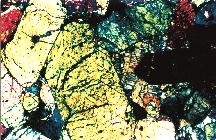
The mineral olivine is a magnesium iron silicate with the chemical formula (Mg2+, Fe2+)
2SiO
4. It is a type of nesosilicate or orthosilicate. The primary component of the Earth's upper mantle, it is a common mineral in Earth's subsurface, but weathers quickly on the surface. For this reason, olivine has been proposed as a good candidate for accelerated weathering to sequester carbon dioxide from the Earth's oceans and atmosphere, as part of climate change mitigation. Olivine also has many other historical uses, such as the gemstone peridot (or chrysolite), as well as industrial applications like metalworking processes.

A Martian meteorite is a rock that formed on Mars, was ejected from the planet by an impact event, and traversed interplanetary space before landing on Earth as a meteorite. As of September 2020, 277 meteorites had been classified as Martian, less than half a percent of the 72,000 meteorites that have been classified.
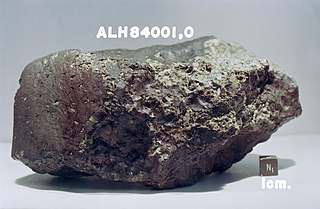
Allan Hills 84001 (ALH84001) is a fragment of a Martian meteorite that was found in the Allan Hills in Antarctica on December 27, 1984, by a team of American meteorite hunters from the ANSMET project. Like other members of the shergottite–nakhlite–chassignite (SNC) group of meteorites, ALH84001 is thought to have originated on Mars. However, it does not fit into any of the previously discovered SNC groups. Its mass upon discovery was 1.93 kilograms (4.3 lb).

Sinus Meridiani is an albedo feature on Mars stretching east-west just south of the planet's equator. It was named by the French astronomer Camille Flammarion in the late 1870s.

An achondrite is a stony meteorite that does not contain chondrules. It consists of material similar to terrestrial basalts or plutonic rocks and has been differentiated and reprocessed to a lesser or greater degree due to melting and recrystallization on or within meteorite parent bodies. As a result, achondrites have distinct textures and mineralogies indicative of igneous processes.

Carbonaceous chondrites or C chondrites are a class of chondritic meteorites comprising at least 8 known groups and many ungrouped meteorites. They include some of the most primitive known meteorites. The C chondrites represent only a small proportion (4.6%) of meteorite falls.

Komatiite is a type of ultramafic mantle-derived volcanic rock defined as having crystallised from a lava of at least 18 wt% MgO. Komatiites have low silicon, potassium and aluminium, and high to extremely high magnesium content. Komatiite was named for its type locality along the Komati River in South Africa, and frequently displays spinifex texture composed of large dendritic plates of olivine and pyroxene.
The Thermal Emission Spectrometer (TES) is an instrument on board Mars Global Surveyor. TES collects two types of data, hyperspectral thermal infrared data from 6 to 50 micrometres (μm) and bolometric visible-NIR measurements. TES has six detectors arranged in a 2x3 array, and each detector has a field of view of approximately 3 × 6 km on the surface of Mars. The TES instrument uses the natural harmonic vibrations of the chemical bonds in materials to determine the composition of gases, liquids, and solids. TES identified a large area that contained the mineral olivine. Olivine was found in the Nili Fossae formation. It is thought that the ancient impact that created the Isidis basin resulted in faults that exposed the olivine. Olivine is present in many mafic volcanic rocks. In the presence of water it weathers into minerals such as goethite, chlorite, smectite, maghemite, and hematite. Olivine was also discovered in many other small outcrops within 60 degrees north and south of the equator. Olivine has also been found in the SNC meteorites that are generally accepted to have come from Mars. Later studies have found the olivine-rich rocks to cover over 113,000 square kilometers. That is 11 times larger than the five volcanoes on the Big Island of Hawaii.

Cumulate rocks are igneous rocks formed by the accumulation of crystals from a magma either by settling or floating. Cumulate rocks are named according to their texture; cumulate texture is diagnostic of the conditions of formation of this group of igneous rocks. Cumulates can be deposited on top of other older cumulates of different composition and colour, typically giving the cumulate rock a layered or banded appearance.

Ureilite is a rare type of stony meteorite that has a unique mineralogical composition very different from that of other stony meteorites. This dark grey or brownish meteorite type is named after the village Novy Urey (Cyrillic: Новый Урей), Mordovia Republic of Russia, where a meteorite of this type fell on 4 September 1886. Notable ureilites are the Novo Urei and the Goalpara, also named for the town in which it landed (Goalpara, Assam India). On 7 October 2008, tiny asteroid 2008 TC3 entered Earth's atmosphere and exploded an estimated 37 kilometres (23 mi) above the Nubian Desert in Sudan. Fragments of this asteroid were recovered the following December and were found to be ureilite. Scientists have discovered amino acids in meteorite 2008 TC3 where none were expected, taking into account high temperatures reached in the explosion of about 1000 °C.

Nakhlites are a group of Martian meteorites, named after the first one, Nakhla meteorite.

The composition of Mars covers the branch of the geology of Mars that describes the make-up of the planet Mars.

The Tissint meteorite is a Martian meteorite that fell in Tata Province in the Guelmim-Es Semara region of Morocco on July 18, 2011. Tissint is the fifth Martian meteorite that people have witnessed falling to Earth, and the first since 1962. Pieces of the meteorite are on display at several museums, including the Museum of Natural History of Vienna and the Natural History Museum in London.
The Brachina meteorite is the type specimen of the brachinites class of the asteroidal achondrites.

Northwest Africa 7034 is a Martian meteorite believed to be the second oldest yet discovered. It is estimated to be two billion years old and contains the most water of any Martian meteorite found on Earth. Although it is from Mars it does not fit into any of the three SNC meteorite categories, and forms a new Martian meteorite group named "Martian ". Nicknamed "Black Beauty", it was purchased in Morocco and a slice of it was donated to the University of New Mexico by its American owner.
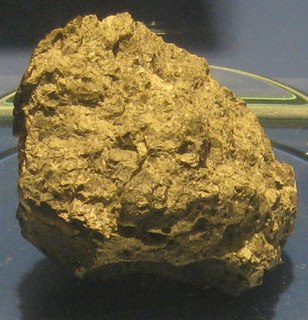
Orthopyroxenite is an ultramafic and ultrabasic rock that is almost exclusively made from the mineral orthopyroxene, the orthorhombic version of pyroxene and a type of pyroxenite. It can have up to a few percent of olivine and clinopyroxene.

Northwest Africa 7325, also known as NWA 7325 is the first meteorite believed to have originated from Mercury. Found in a marketplace in Erfoud, Morocco in April 2012, the meteorite is composed of 35 fragments with a combined weight of approximately 345 grams (12.2 oz). Investigation of the meteorite by Anthony Irving at the University of Washington determined that the meteorite's composition is consistent with that of Mercury as determined by the MESSENGER spacecraft. Irving cautioned, however, that NWA 7325 could also have come from a smaller but Mercury-like body; an alternative explanation offered is that NWA 7325 may be a primitive achondrite. Notable for its green fusion crust and high-magnesium/low-iron composition, NWA 7325 is estimated to be 4.56 billion years old and was likely ejected from Mercury on an Earth-intersecting trajectory by an impact.
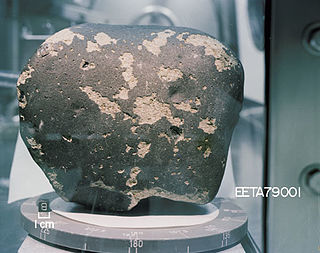
Elephant Moraine 79001, also known as EETA 79001, is a Martian meteorite. It was found in Elephant Moraine, in the Antarctic during the 1979–1980 collecting season.
Zagami is the largest single Martian meteorite ever found, weighing about 18 kilograms (40 lb). It landed 10 feet (3.0 m) from a farmer near Zagami, Nigeria, and became buried in a hole about 2 feet (0.61 m) deep. According to Ron Baalke of NASA/JPL, "The Zagami meteorite is the most easily obtainable SNC meteorite available to collectors," referring to the SNC classification of meteorites, of which Martian meteorites belong.
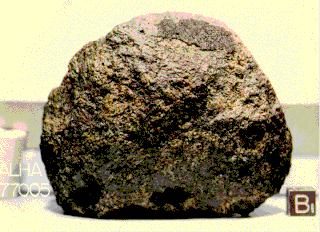
Allan Hills 77005 is a Martian meteorite that was found in the Allan Hills of Antarctica in 1977 by a Japanese National Institute of Polar Research mission team and ANSMET. Like other members of the group of SNCs, ALH-77005 is thought to be from Mars.
